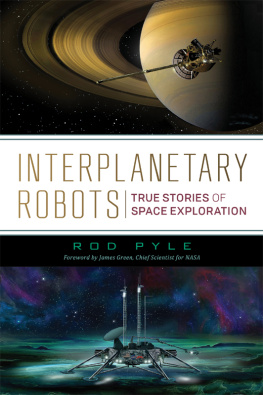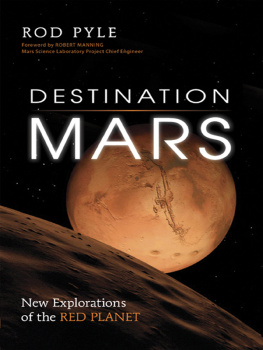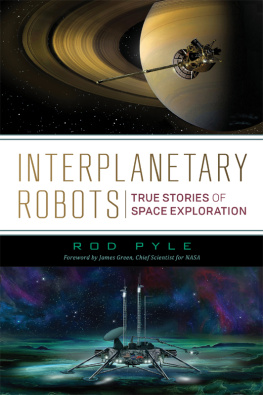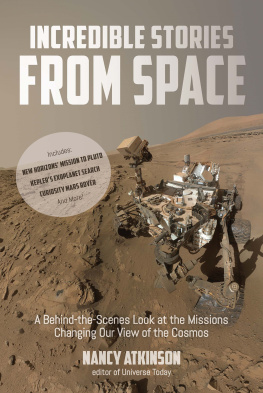
If you were to somehow find yourself floating in deep space sometime in 2024, about ten billion miles past the orbit of Pluto, and you were in the perfect spot, you would be in for an extremely brief treat. Swiveling your gaze away from the starry panorama of the Milky Way and beyond, looking back from where you came, you would see a dim starsomewhat brighter than the others, but unremarkable, and that would be our sun. Earth would not be visible without a powerful telescope. But wait one momentthere is a tiny, dark speck coming toward you, almost blotting out the wan image of the sun.
In the time it takes to write this, a timeworn spacecraft hurtles past you, traveling at some 38,610 miles per hourand then it's gone into the black void. That was Voyager 1, which has been speeding through space since 1977. The probe passed the distance of Pluto, about 4.67 billion miles from the sun, back when big hair bands like Van Halen still topped the music charts in the 1980s. It traversed the vaguely defined edge of the solar system in 2012, and continues its journey past you into interstellar space, the void between stars.
Why did I pick 2024 to thrust us into this chilly spot in the void beyond the solar system to witness this blistering flyby? Because sometime that year, or perhaps the next, or the one after that, will be the end of the history-making missions of Voyagers 1 and 2. At that time, the available power from its plutonium-238 fuel source will be too weak to power its instruments. The dwindling radio signal from the spacecraft will also be increasingly difficult to track from Earth, now over 15,500,000,000 miles distant. That nuclear power supply will continue to generate heat, which it converts to electricity, for hundreds of years, but its ability to create useful levels of electrical current will be long gone by then. While the plug of plutonium will still be hot for the rest of the twenty-first century, the devices that convert that heat, called thermocouples, will have long since degraded in their ability to do their job; and the current produced while they are still active will be too little to run the spacecraft. Hence the mission cutoff date of sometime in the mid-2020s.

Fig. 1.1. Here comes VoyagI mean, there goes Voyager. At 38,000 miles per hour, you would not have long to snap this photo as it streaked by. Image from NASA.
As of 2019, the Voyager 1 and 2 continue their quiet journey past the rim of the solar system, venturing through the great emptiness beyond. Their final encounter with a planet was that of Voyager 2, which screamed past Neptune in August of 1989. The probes had to work quickly during these planetary flybysit was only later, with spacecraft like the Jupiter-bound Galileo and Cassini, which flew past Saturn, that these giant machines were actually able to orbit the massive worlds they studied. But before that went Pioneer 10 and 11, the aptly named first spacecraft to traverse the outer planets, and the Voyagers were the first to do detailed work there. Much later, Voyager 1 was the first to pass beyond the edge of the solar system, also known as the heliosphere. (Voyager 2 had a longer route to follow, and is just crossing that thick boundary layer now.) The Pioneers and the Voyagers will continue their journey through space for billions of years, passing distant star systems in the future: Voyager 1 will pass a star named Gliese 445 in about 40,000 years, at a distance of about one and a half light years, and Voyager 2 will pass another star called Ross 248 by nearly the same distance at about the same time.
But both started out from the Earth, and are the children of NASA's Jet Propulsion Laboratory (JPL), which is where our story begins.

August 5, 2012, is yet another hot August day in Southern California. While the entire region sits in a smoggy haze throughout the summer, the San Gabriel Valley, Los Angeles's northeastern quadrant, generally gets the worst of it. The prevailing winds often blow in from the ocean, about twenty miles distant as the crow flies, moving past the complex of freeways that crisscross the megalopolis. This breeze scrapes up the emissions from the millions of cars that sit in twenty-four-hour gridlock across the city. That smog warms and darkens through photochemical reactions with the sun and is slowly pushed over the mid-city hills to settle into the inland valleys. Once there, it heats, and sits, and heats some more, becoming increasingly acrid with each passing afternoon hour. This day is no exception, but at least it is not roastingly hot. While the summer heat here can easily top three digits by egg-frying margins, the temperature on the fifth is only about 82 degrees, with low humidityin downtown Los Angeles anyhow. Cross into the valley and the temperatures magically elevate by an average of ten degrees. Hot indeed, but not too daunting for a quick drive up to NASA's Jet Propulsion Laboratory, just a few miles northwest from my home, on this auspicious day.
As I head up to The Lab, as it's often referred to in these parts, the sky overhead is almost bluenot a small accomplishment for midsummer, when LA smog peaks. JPL is tucked into the southern slopes of the San Gabriel Mountains, and for the past four months the scrub brush surrounding it has been brown and deadSouthern California is in yet another period of prolonged drought. A few scruffy trees struggle to cling to life in the arid climate, creating a vague green halo around the edge of the JPL campus.

Fig. 2.1. NASA's Jet Propulsion Laboratory is nestled in the San Gabriel Mountains, not far from Pasadena, California. This is a rare smog-free photo. Image from NASA.
Getting off the freeway, the traffic lightens and the midday trek up the steep street that dead-ends at JPL's front gate is a quick drive. While the NASA center's mailing address is in Pasadena, California, its physical location lies in a suburb called La Caada Flintridge. These sprawling postwar communities are chock-a-block with small two- and three-bedroom bungalows built to accommodate returning Second World War GIs and their rapidly expanding families in the 1940s and 1950s, and were an affordable alternative to the more expensive regions closer to metropolitan Los Angeles and their tony Western relatives of Hancock Park, Beverly Hills, and Santa Monica. But this is no longer the casethe average price of a plain-Jane ranch-style home of about 1,600 square feet in this locale in 2012 soared to nearly a million dollars (and in 2018 it's almost $2 million). It's a high price to pay to live in the overheated northeastern suburbs, but with JPL resting in a crook in the northern foothills, the only areas that don't require a lengthy commute are here and nearby Pasadena or La Crescenta. During rush hour, a trek from the more affordable communities to the east, let's say up to about thirty miles away by freeway, can take well over two hours one way.
The final leg of my journey is a steep climb up Oak Grove Drive, which earns its name from the procession of old oak trees that line its sides. The cooling shade they provide is a welcome relief for the (mostly younger) engineers and scientists that troop up the hill by foot every daythe workforce tends to take environmentalism seriously, as many of their Earth-orbiting machines report back the bad news on climate change daily. They are a committed bunch, their well-worn Nikes and Birkenstocks a testament to their commitment to environmentalism.
Next page















